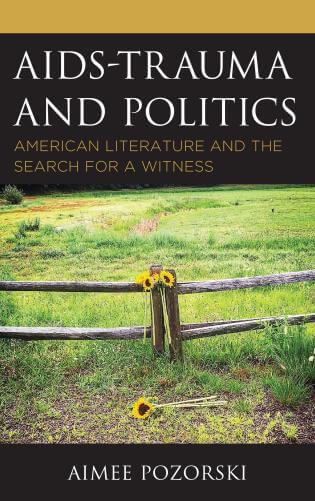Review of Aimee Pozorski’s AIDS-Trauma and Politics: American Literature and the Search for a Witness

AIDS-Trauma and Politics: American Literature and the Search for a Witness. Aimee Pozorski. Lanham: Lexington Books, 2019.
American culture and politics has a lot to learn when it comes to effectively grappling with health crises and systemic inequities. As we navigate a global health pandemic with COVID-19, Aimee Pozorski’s book AIDS-Trauma and Politics: American Literature and the Search for a Witness resonates with ongoing struggles to not only intervene in health crises and provide necessary care, but to also successfully bear witness to such crises multi-faceted impacts. In AIDS-Trauma and Politics, Pozorski charts the deafening silence surrounding the emergence of AIDS, calling our historical memory, and the narratives that defined these cultural perceptions, into question. This silence characterized the Reagan administration in particular, with Ronald Reagan speaking for the first time about the existence of AIDS in 1987, despite the Centers for Disease Control and Prevention first identifying the disease in 1981 (1). Yet, as the author emphasizes, what is not said carries comparable weight to that which is said regarding social traumas. Amidst an overwhelming silence about AIDS, rampant homophobia shaded the cultural depictions of AIDS that did circulate, serving to reinforce heterosexist attitudes and stigma. Pozorski evidences a profound commitment to honor those impacted by AIDS, both those diagnosed and their associated networks of care, by investigating how we capture the trauma, grief, empathy, and other complex dimensions of experience in stories of illness.
The author laments the shortcomings of scientific documentation in articulating these complexities and appreciating the intimacies surrounding AIDS stories. Pozorski looks at the impact of narrative medicine in identifying how AIDS took shape, emphasizing that the integration of storytelling into medical documentation signified a turning point in hearing and understanding the voices of AIDS. The author looks at the medical field’s activism in conversation with the cultural texts that informed social understandings of the AIDS crisis. Pozorski sees literature and art as offering a unique set of possibilities for bearing witness to AIDS, a concept the author understands as fundamental to cultivating awareness, empathy, and tangible social change for preventing and managing AIDS. For Pozorski, to bear witness is to not only acknowledge AIDS as a crisis, but to interrogate the spaces between narrativizing and activism, the silences, the affective contours, and all of the other seemingly inarticulable facets of grappling with the social trauma of widespread illness. The temporal disconnect between medical and social progress with regards to AIDS awareness deserves attention, as Pozorski notes that “social understandings of AIDS lag behind medical advancements, perpetuating the failure to bear witness (42).”
There is a reparative work involved in compensating for the political and cultural failure to recognize AIDS as a crisis, and Pozorski argues that literature, theater, and film provide entry points for brainstorming what atonement might look like. Pozorski explores the use of metaphor and confession to “represent the unimaginable” (73). From Paul Monette’s use of military imagery to acknowledge the battles waged as a result of AIDS to Mark Doty’s engagement with gardenias to gesture at new life, Pozorski wrestles with the complicated work of signification. To articulate what feels impossible to accurately capture through non-fiction writing or activist rhetoric requires artistic devices and methods that make space for what is simultaneously abstract and profoundly felt.
Plays such as Tony Kushner’s Angels in America and Larry Kramer’s largely autobiographical The Normal Heart conveyed the tension and grief surrounding political silence on AIDS alongside activists’ relentless debates on strategies to be heard and seen. The LGBTQ+ community struggled not only in resistance to the Reagan administration, but also within activist circles about best practices around language and tactics for facilitating social movement. Feuds between playwrights such as Sarah Schulman and Jonathan Larson conveyed the tension surrounding activist strategies and commitments. Although Jonathan Larson’s Rent is often credited with promoting mainstream awareness of lived AIDS experiences, Pozorski draws attention to how Rent lifted content from Sarah Schulman’s People in Trouble and watered down the political storyline in favor of interpersonal drama. In People in Trouble, Schulman’s narrative highlights how gentrification tied into the stories of those living with AIDS (117). While Pozoroski looks at how displacement and housing insecurity contributed to the struggle of those impacted by AIDS, the author overlooks the need to see gentrification through an intersectional lens. Transphobia and racial injustices complicate and exacerbate the effects of gentrification for those living with AIDS, yet these dimensions of LGBTQ+ oppression don’t make it into Pozorski’s discussion.
Pozorski wraps up her book by engaging the work of authors, such as Michael Cunningham, to investigate the ethics of literary representation. Bearing witness to the AIDS crisis involves a certain obligation to document what voices were left out and what experiences remain marginalized by historical memory. Literary and artistic expression offers a mechanism for centering those who have been pushed to the margins. There is a question raised in this discussion around what constitutes collectivism in art, and Pozorski argues to make room for “cracks in the collective” by recognizing the limits of collectivity (129). Here, the author makes space for reparative work of her own. In addition to sidelining intersectional facets of LGBTQ+ oppression, the author’s blind spot with regards to race takes shape by failing to include any Black literary and artistic voices throughout the book, generating an understanding of the “collective” impacted by AIDS-trauma to be distinctly white. Although Pozorski holds herself accountable in the Afterword for this lack of racial diversity, the book’s capacity to bear witness to AIDS-trauma is limited by who is centered in the analysis. Engaging AIDS narratives from those that experience multiple marginalizations based on race, disability, class, and sexuality would enrich our understanding of how AIDS-trauma manifests, and expand the possibility for generating social change that accounts for all those impacted by AIDS.
Also available is Kimberly Hurd Hale’s review and an excerpt of the book.




